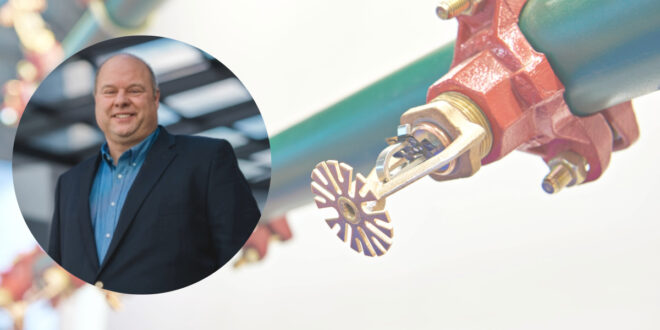I like my end-of-the-year column to acknowledge what the technical team did well and what we would like to focus on next year. This gives me time to adjust my management style and goals to the needs of our membership while accomplishing our mission. I want AFSA to be the best in sprinkler industry training!
What can I say? What a year! We saw a record number of in-person AFSA chapter and allied organization meetings and training events. The technical staff visited over 75% of AFSA’s chapters. At most of those, we held an eight-hour training session for a packed room of attendees. My staff felt excitement in the room. We attended over 30 allied organizations to build our brand recognition. The AHJ training events we completed have produced outstanding results. Our AHJ membership has increased to over 2,000 AHJs. We have heard from our members that the AHJs who attended our presentations have a better understanding of the installation standards. This understanding leads to more uniform enforcement of the installation standards for our industry. Uniform enforcement leads to less aggravation and saves money for our contractor members.
Our technical review service is on pace to exceed 600 questions this year. We will receive about 50 questions from AHJs. It makes me proud when the AHJs ask us questions. It is my thought that when an AHJs member asks us a question, it indicates that he or she trusts AFSA to give them a clear, concise, factual answer based on the applicable NFPA standards.
Our involvement with the NFPA process is paying dividends. Our Technical Advisory Council (TAC), consisting of 41 members, started this year and is producing excellent results. We currently have representatives on 45 different NFPA standards, with 55 technical committees and 118 seats, both principal and alternate. Our working relationship with the NFPA staff is in good shape. Our Director of Program Development & Special Projects, Victoria Valentine, is on the NFPA Standards Council, and I’m on the NFPA Research Foundation Board of Trustees. During the annual NFPA standards meeting held during the NFPA Conference & Exposition in Orlando this year, AFSA staff presented and pushed our issues. Most of our Certified Amending Motions (CAMs) were decided in our favor.
AFSA43 was held in Denver this year. While I knew this event would be great, I thought we could not exceed AFSA42 regarding attendance. Face it, AFSA42 was held in Orlando. Orlando is not going to beat Denver. Well, I was totally wrong. AFSA43 was a total success beyond my wildest imagination. The technical presentations were packed, and the comments we received were great. The biggest complaint I heard was that too many good presentations were held simultaneously. The attendees wanted to attend multiple presentations at the same time. Hmm, I’m not sure what to do with those type of comments. Our call for presentations for AFSA44 is currently out. I’m hearing from industry professionals that our conference is the “can’t miss event” of the year. The exhibition hall was sold out and packed with attendees. The apprenticeship competition was a huge success. Seeing seven young men perform in the field in front of a crowd and seeing how they did on our written tests makes me feel we are on the right track. Our Sprinkler Fitting Apprentice Training series books were revamped several years ago under the direction of our Vice President of Education Services Leslie Clounts and our Technical Development Specialist Veronica Westfall with a team of volunteer members. What a job! These apprentices studied using those books. Great job, apprenticeship finalists! Your training will continue to pay off.
How can we do better? There is always a need for improvements. My biggest goal is to utilize our training facility more fully. Due to outside construction issues, we struggled to have our water supply and pumping systems fully operational. As I write this column, these issues are almost behind us. Next year will allow us to fully utilize our training lab. I want to see it used every day possible. Seeing students in the lab helps us fulfill our mission to educate and train the industry while promoting fire protection systems to save lives and property. If you or members in your organization need training, look at AFSA for the training. We can fulfill your needs.
I want to publicly thank my hard-working technical team. Eric, Josh, and Kevin go above and beyond. They do what it takes to get the project done. This includes putting in extra hours and long travel schedules. They all have an attitude I love—do what is needed to the best of my ability for the benefit of our members. I want to welcome and introduce the newest member of my team, Hayden Stoll, who is currently a student at the University of Maryland. He is working on earning his Bachelor of Science degree in fire protection engineering. If all goes as planned, he will graduate in May 2025. At this point, he is working as an intern for us handling various assignments. Hayden did attend AFSA43 as our guest. He did not hesitate and jumped right in. Hayden has a bright future.
And finally, in January, I will reach my five-year work anniversary at AFSA. I cannot believe how quickly the years have gone by. I have seen this association change positively for our members. It is my pleasure to serve our President Bob Caputo, our Board of Directors, and, most importantly, our members. Thank you for letting me serve you! And, I can not forget to say thanks to God, my wife Donna, and the rest of my family for the ability, inspiration, and tolerance to let me do what I want to do. The thing I do enjoy more than presenting is holding my grandson Zachary!
ABOUT THE AUTHOR:

John August Denhardt, P.E., ET, CWBSP, FSFPE, is the vice president of engineering and technical services for the American Fire Sprinkler Association (AFSA). He is responsible for strengthening AFSA’s engineering and technical approaches to meeting member, industry, and operational priorities, with an emphasis on service, quality, and integrity. Denhardt is a registered professional engineer (P.E.) in the District of Columbia and the states of Delaware, Maryland, Pennsylvania, and Virginia. He is NICET Level III certified in water-based systems layout, NICET Level III certified in inspection and testing of water-based systems, and a certified water-based system professional through NFPA. Denhardt is a member of the NFPA 13 technical committee on sprinkler system discharge criteria, a fellow in the Society of Fire Protection Engineers (SFPE), a member of the SFPE Board of Directors, a member of the Board of Trustees for NFPA’s Fire Protection Research Foundation and sits on the University of Maryland Department of Fire Protection Engineering’s Board of Visitors. A native of Maryland, Denhardt holds a Bachelor of Science degree from the University of Maryland College Park in fire protection engineering. Prior to this role, Denhardt was employed by Strickland Fire Protection in Forestville, Maryland, since 1994, overseeing large-scale projects and assisting with design and installation technical issues.
 Sprinkler Age A Publication of the American Fire Sprinkler Association
Sprinkler Age A Publication of the American Fire Sprinkler Association
